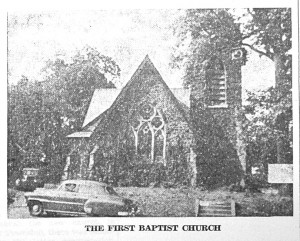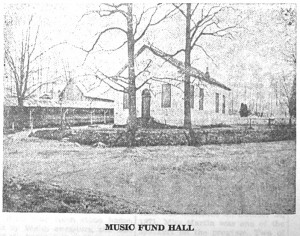Apparently there was never any shadow of doubt in the minds of those pioneer members of the Radnor Baptist Church as to the answer to the question “Am I my brother’s keeper?”. It would seem that no one ever hesitated to serve on a committee, or to visit alone, any “delinquent” member of the church. However, reports were brought back so frequently to church meetings that these committees or individuals were not able to see “the erring Brother or Sister when they called” that some doubt must arise in the minds of a reader of these Church Minutes as to whether these delinquents were not either conveniently absent or perhaps even hiding very quietly behind closed doors!
The indignation of one member when he was called upon by a committee was apparently so righteous that the committee was dismissed after making its report. According to the church minutes, “The Committee Brothers P. and B. reported that they had an interview with Bro. M., who said that false reports had been circulated in regard to his being Drunk, Swearing, etc. Said he did not get drunk before he was converted and that it was not likely he would now, and that he had passed through severe afflictions, and that the Lord had been with him, and that he still desired to serve the Lord and belong to his Church and people, and the Committee reporting favorable on behalf of our brother, the Committee was Discharged.”
Not content with taking any chances on not hearing of the possible delinquency of a church member in the matter of drinking, the minister had a resolution spread on the Church minutes, “That we as church members are under obligation to report to the church if we know of any member that is in the habit of using intoxicating liquors as a beverage”. The definition of “intoxicating” became a question of such moment that the following paragraph appeared in the minutes of August 22, 1861:
“That on next meeting for business we consider the question, whether the wine or juice of the grape that we use on our Communion occasions, it being somewhat fermented, is of such a kind as the Scriptures teach, and whether it is in accordance with the principles and former acts of our Church.”
This question was apparently settled without delay, for very shortly thereafter a resolution appeared on the minutes to the effect that “On motion proceeded to the consideration of sacramental wine, or juice of the grape, whether we use it after it becomes fermented it was resolved that hereafter we will use syrup or some substitute in which there shall be no alcohol”.
— of these incidents having occurred during the pastorate of Brother S., one wonders a bit if there is any connection between it and a “communication from —- L.”, in which the latter —- his resignation of that office —-olds in the church, giving as seen that he could no longer be —ted by the preaching of Mr. A. and that it was useless to attest to ministrations”. Brother L.’s resignation “was granted”.
As —– sinful living was concerned, it would seem that dancing —- on part with swearing —–. The Committee, who ———- Brother P. reported ——- he was willing to say ——– no more while he ——- of the church, yet ———- acknowledge its sin———— he had done wrong, and refused to fill his place in the Church and spoke of the Pastor in an unbecoming manner”. And so “in view of his past and general Christian conduct, it was deemed best to exclude him”. And it was only shortly after this incident that “Sister Emily Siter was appointed a committee to wait on Sisters M. and A. G., for the wrong of being found participating in a public dance.”
Although written some 84 years ago, there is a very present day ring to the phrase used by pastor Dalley when he gave “the high price of living” as the reason for refusing to continue to the service of the church unless his salary was raised to $650 per annum. Twenty-six years before that the Church’s first minister had received $350 yearly! For one reason or another there were constant pastoral changes. There were also as many changes of sextons. One sexton flatly refused to give up his keep until the church “payed” him. This one of the church brethren agreed to do, but with the clear understanding that “the church pay him back within one monh.”
However, it was undoubtedly due to inability to contribute more to church expenses, rather than unwillingness to give more that made for an almost constantly empty treasury. Even when a new minute book was needed it was ordered that “a collection be taken up every Sabbath evening for this and other expenses of the church, so long as we have need of it.” But in some fashion larger expenditures were met.
A parsonage was erected, the one still standing between the site of the large church which is being demolished and the present trolley tracks. Later there was a stable and a carriage house. In July, 1864, a committee was appointed to take care of repairs to the meeting house, “the roofing of the house and rebuilding the chimneys to be first in order and carpet for the floor and after that the painting of the woodwork of the house and then blinds for the windows if funds hold out.”
There is frequent mention of the little old school house which antedated even the church building itself. One note states that “it is to be rented to the School Board for $25 per year.”
On September 13, 1861, “it was resolved that this church observe the 26th day of the month as set apart by President Lincoln as a day of humiliation, prayer and fasting for the blessing of the Lord on our country.” Those were the early days of the War of Secession. This September 13 was a time following closely on the Battle of Bull Run, the first serious encounter of the War, a battle in which Northern forces suffered great defeat at the hands of the Confederates. Although no further reference is made in the minutes to the Civil War, its outcome must have been a source of great satisfaction to members of the Radnor Baptist Church, with the strong anti-slavery attitude they had always maintained.
A simple marginal note in the first Record Book of the church states that “Deacon Siter departed this life July 24, 1857.” Members of the church meeting of July 23 had stated that “Bro. G. Philips was appointed collector of the pastor’s salary in place of Bro. Siter, who is not able on account of sickness.” For 16 years William Siter had served his church faithfully and well, after having been the leading spirit in starting it. Among three interesting old parchment documents held by the remaining trustees of the church property when it was sold recently, was the “Charter for Incorporating the Radnor Baptist Church.” William Siter is named in it as one of the original seven trustees, the other six being George Philips, John Beaver, George W. Lewis, Samuel Jones, Gideon D. Thomas and WIlliam Supplee. This was dated November 30, 1842.
Of the other old documents, one is the deed of recording the gift of land to the church on April 28, 1843, “from William Siter and Emily, his wife.” The third document is the deed of an acre of ground given by the church by Emily Siter on the sixth day of April, 1861. By that time only three of the original trustees were in office. The others serving were Thomas R. Pelty, John Jones, Charles Pugh and Peter Bloom.
For almost 50 years the congregation of the Radnor Baptist Church used the small building originally known as Music Fund Hall as its meeting place. Then, at a church meeting held on July 22, 1889, the minutes state that “after a very earnest prayer by Bro. Miller, we decided to tear down the old church and build a new one.” At a September 15 meeting it was further resolved “that the trustees of the Radnor Baptist Church arrange to have the old meeting house torn down and a new one erected and that they further be empowered to take all essential measures to secure the money to meet the indebtedness incident to the construction of the building.”
The old minutes book of the Radnor Baptist Church tells nothing of the actual building of the church that is now being demolished. if anyone knows who the architect and builder were, how the funds for it were raised, and any other details, will that person get in touch with Mrs. Patterson, Windermere Court, Wayne 4569?
(To be continued)


